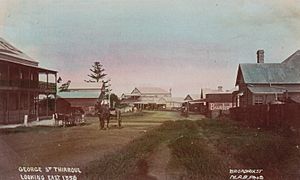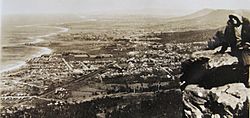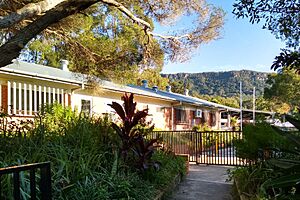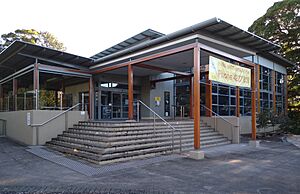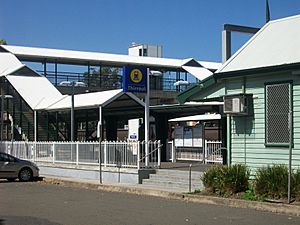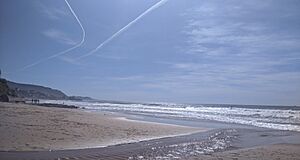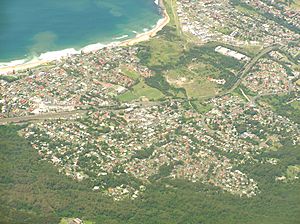Thirroul, New South Wales facts for kids
Quick facts for kids ThirroulWollongong, New South Wales |
|||||||||||||||
|---|---|---|---|---|---|---|---|---|---|---|---|---|---|---|---|
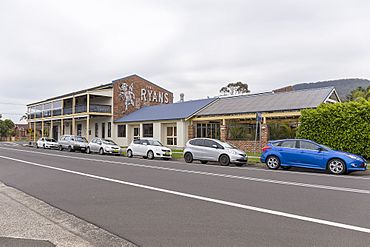
Ryan's Hotel
|
|||||||||||||||
| Population | 6,083 (2016 census) | ||||||||||||||
| Postcode(s) | 2515 | ||||||||||||||
| Elevation | 18 m (59 ft) | ||||||||||||||
| Location |
|
||||||||||||||
| LGA(s) | City of Wollongong | ||||||||||||||
| State electorate(s) | Heathcote | ||||||||||||||
| Federal Division(s) | Cunningham | ||||||||||||||
|
|||||||||||||||
Thirroul is a lovely seaside suburb located north of Wollongong, Australia. It sits between the towns of Austinmer and Bulli. Thirroul is about 13 kilometres north of Wollongong and 73 kilometres south of Sydney. It is nestled between the Pacific Ocean and the beautiful Illawarra escarpment.
Contents
What's in a Name?
After European settlers arrived in the 1860s, the town was first called North Bulli. In 1880, it was renamed Robbinsville after a local landowner, Frederick Robbins.
The name Thirroul was officially adopted in 1892 by the Railways Department. This name likely came from Archibald Campbell. He was interested in Indigenous languages. His notes suggested the Aboriginal word Dthirrawell for the cabbage tree palm. These palms grew widely in the area.
However, there was some confusion about the name. In 1892, an Aboriginal elder named William Sadler said Thirroul was meaningless. He claimed the correct word was throon, which meant "bush leeches". A local historian, Joseph Davis, later found that Campbell's original writing was hard to read. A clerk had misread Dthirrawell as Thirroul.
Thirroul's Past: A Brief History
Before European settlement, the Wodi Wodi Indigenous Australians lived here. They called the area Thurrural. This name meant "The Valley of the Cabbage Tree Palms". These palms were very common and early settlers used them for strong fence posts. You can still see these trees near Bulli Pass.
Early settlers arrived in the late 1860s. They built homes in the hilly parts of the village. The beachside area was often swampy and flooded. People worked in farming, logging, whaling, and fruit growing. Later, coal mining began when the Bulli Mine opened in 1859. The Bulli Jetty was built in 1863 to ship the coal.
The town was known as North Bulli. In February 1880, it became Robbinsville. This name was chosen at a meeting of ten men, including Frederick Robbins. One idea for a name was "Mudmire," but Robbins convinced them to name it after him. By 1891, the town had 490 people.
In 1892, the name "Thirroul" was officially adopted by the Railways Department. This was likely due to Archibald Campbell's influence. He had listed "Thirroul" (cabbage tree) and "Throon" (bush leech) in his notes on Aboriginal words. William Saddler, an Aboriginal elder, said "Throon" was the correct name. He explained it referred to the many leeches found on the escarpment.
The railway link to Sydney was completed in 1888. This brought more people to Thirroul. The eastern side of town grew quickly. The Thirroul Railway Depot opened in 1917 but closed in 1965. Only the barracks for railway crews remain. The Railway Institute Hall, opened in 1920, is now a heritage building. The railway also made Thirroul a popular holiday spot. Families loved coming for seaside vacations.
Two important early residents were Samuel McCauley and Frederick Robbins. McCauley was one of the oldest residents of the Illawarra area. A street in Thirroul is named McCauley Street after him. Robbins was the first postmaster of Robbinsville in 1888.
In 1898, the ship Amy was shipwrecked on the rocks at Thirroul beach. All its crew members died. A memorial plaque for the Amy is in Thirroul Beach Park. Coal mining started in the early 1900s, bringing more people to live in the area.
The famous English author, D.H. Lawrence, visited Thirroul in 1922. He wrote his novel Kangaroo here. The book was about Australian politics after World War I. His house, Wyewurk, overlooks the Pacific Ocean. It is an early example of the Californian Bungalow style in Australia.
Lawrence described the town: "The town trailed down from the foot of the mountain towards the railway... There were wide unmade roads... with little bungalow homes... Then quite near the inland, rose a great black wall of mountain or cliff."
The Thirroul Village Committee (TVC) started in 1983. They wanted to improve the town's appearance. In 1993, the TVC won an award for improving streetscapes. The Thirroul Seaside and Arts Festival was also started by this group in 1993. It is a very successful community event.
Another community event was the "Growing Green Kids Festival." This not-for-profit event was created by Cate Wilson. She was also president of the Thirroul Action Group (TAG), an environmental group.
In August 2007, Thirroul's main shopping area and beach became an alcohol-free zone. This was to prevent public drinking. Anita's Theatre, an old picture theatre, reopened in 2007 after being renovated. It was named in honour of the developer's late wife.
Don Gray, a long-time Thirroul resident, published his memories in a book called My Thirroul in 2011. A children's playground was opened in 2012 with a plaque honoring Don Gray. Some artwork at the playground shows his memory of an elephant stuck in the old Thirroul Beach lagoon.
You can find a lot of information about Thirroul's history on the "Thirroul History in Photos" Facebook page.
Heritage Sites
Thirroul has some important historical places. These are called heritage-listed sites.
- Illawarra railway: Thirroul railway station
Shops and Services
Thirroul has a busy shopping area. It stretches from just north of Bulli Pass to Thirroul Station. You can find supermarkets like Coles and IGA. Many new shops are opening as Thirroul grows.
There are many cafes, making it a popular place for visitors. The Beaches Hotel and Ryans Hotel are lively pubs for both locals and tourists. Thirroul also has fashion, gift, and lifestyle shops. King's Theatre (built in 1913) was renovated and renamed Anita's Theatre in 2007. This theatre is now owned by a Sydney buyer.
Thirroul is the main shopping area for the northern suburbs of Wollongong. It has clothing stores, florists, news agencies, and more. There is also a local branch of the Returned and Services League of Australia (RSL).
The Northern Illawarra Chamber of Commerce helps local businesses grow. It works with business owners, residents, and tourism groups.
Thirroul has two primary schools. St. Michael's is a Catholic school established in 1940. Thirroul Public School opened in 1889. Frederick Robbins sold land for the school and a teacher's home. The school started with 154 children. Thirroul also has a Scout Group.
In June 2009, the new Thirroul District Library and Community Centre opened. This library offers computers, printing, free internet, and programs for children.
The annual Thirroul Seaside & Arts Festival is held in early April. It includes art shows, workshops, kids' activities, live music, and stalls. The festival won a tourism award in 2003. It involves many community groups, schools, and sports clubs.
Who Lives Here?
In the 2016 census, 6,083 people lived in Thirroul. Most residents (79.9%) were born in Australia. The next most common birthplaces were England (5.5%) and New Zealand (1.7%). Most people (89.7%) spoke only English at home.
The most common religions were No Religion (37.8%), Catholic (24.4%), and Anglican (16.7%).
The average weekly household income in Thirroul was $1947. This is higher than the average for the Wollongong area. More people in Thirroul have completed university education (60%) compared to the Wollongong average. Many people work in higher education, hospitals, and schools.
Many people from Sydney have moved to Thirroul and travel to Sydney for work. This has caused house prices to increase.
Getting Around Thirroul
Thirroul railway station is an important station on the NSW TrainLink South Coast line. Local trains to Wollongong end here. All Intercity trains stop at Thirroul. In 2005, lifts were added to the station.
Thirroul also has special railway tracks for coal trains. These trains carry coal from nearby mines.
Lawrence Hargrave Drive starts south of Thirroul in Bulli. It goes north through Thirroul and connects to other main roads.
Thirroul Beach Fun
Thirroul beach is a major attraction. The tall escarpment behind it is great for bush-walking. The beach is popular with locals and tourists, especially in summer. It is 1 kilometre long and has a large grassy area behind it.
Swimming can be tricky due to strong currents called rips. Lifesavers patrol the beach in summer. There is also a 50-metre ocean pool near the beach.
The Thirroul Surf Lifesaving Club started in 1907. It was one of the first surf clubs in NSW. The club has a strong inflatable rescue boat (IRB) racing team. Famous Ironman champions Darren and Dean Mercer are from Thirroul.
The southern part of Thirroul Beach is called McCauley's Beach. It is separated by rocks and is a popular beach for dogs to run off-leash.
Thirroul is known for its reliable surf all year round. The best winds for surfing come from the west north-west. Most waves come from large ocean swells, especially from the south-east. The beach offers both left and right-hand waves. Be careful of rips, rocks, and bluebottles in summer.
Nature and Wildlife
The area south of Thirroul, near Sandon Point, has seen debates about new developments. These discussions involve environmental groups and Aboriginal groups. They are concerned about Aboriginal heritage sites and coastal wetlands. There is also a bike track that runs from Thirroul south to Wollongong.
The escarpment area is home to many different birds. Some birds seen in the northern Wollongong suburbs include the Australian King Parrot, Crimson Rosella, Eastern Sea Eagle, and Brown Gerygone.
Sports in Thirroul
Sports have always been important to Thirroul's community. Many local sports clubs have a long history.
Thirroul is represented in rugby league by the Thirroul Butchers. The Butchers started in 1913. They attract large crowds to their games.
Thirroul is also home to the Thirroul Junior Football Club (TJFC). This club has many junior teams for boys and girls. It also has senior women's and men's teams. The women's teams are known as 'The Thunderbirds'.
Football (soccer) is played at Thomas Gibson Park. Rugby league is played at the northern end of the park, which has a grandstand. Thirroul is also part of the Northern Suburbs Netball Club. The Thirroul Amateur Swimming Club has been active since 1954.
The Thirroul District Cricket Club started in 1896. They used to play at Gibson Park. In the mid-1990s, the senior cricket club moved and changed its name to Northern Districts Cricket Club. The junior club uses both names.
Town Growth and Changes
It's easy to travel from Thirroul to Sydney by train. This has made Thirroul a popular place for people from the city to move to. Many houses in Thirroul are being redeveloped or split into two homes. This increases the number of people living in the area.
This growth puts pressure on the roads. Lawrence Hargrave Drive is the only main road through the northern suburbs. More homes mean more traffic on this road.
Thirroul is known for its village feel. People enjoy parking easily to visit local cafes and shops. Residents are worried that new developments might change this village atmosphere.
In early 2020, a large plan was proposed for the Thirroul Plaza site. The plan suggested a three-story building with shops and 80 apartments. This would block views of the escarpment and remove most street parking. Local businesses and residents are concerned about how this would affect Thirroul.
A group called Save Thirroul Village was formed in 2020. They work with the Thirroul Village Committee to oppose this development. They help the community share their concerns. These groups are working together to ensure the best outcomes for Thirroul's future.
Thirroul in Culture
Thirroul is featured in a musical piece called Small Town by Australian composer Peter Sculthorpe. The music tries to capture the feeling of Thirroul. It includes sounds that remind listeners of the town's buildings and an ANZAC Day ceremony at the war memorial.
Places of Worship
- St Michael's Catholic Church
- St David's Anglican Church
- C3 Church Thirroul
Famous People from Thirroul
- Phyllis Mary Nicol (1903-1964) – a physics lecturer at the University of Sydney. She was born here.
- John Douglas Gibson – an expert on birds (ornithologist).
- Dean Mercer – a famous ironman.
- Graeme Wynn – a rugby league player.



